THE CRAFTSMAN MAGAZINE LIGHTING ARTICLE
 We move into a new house, even an old house that’s new to us, & the electrical is just there, be it knob & tube, or an updated system. It wasn’t always this way! Part 1 explains how we got from stumbling around in a dark cave, to our modern day use of electricity which is pretty casual.
We move into a new house, even an old house that’s new to us, & the electrical is just there, be it knob & tube, or an updated system. It wasn’t always this way! Part 1 explains how we got from stumbling around in a dark cave, to our modern day use of electricity which is pretty casual.
Although much of the information is this article is pretty much taken for granted, I appreciated the advice given about the use of light bulbs & shades.
LIGHTING THE HOME BY ELECTRICITY
THE CRAFTSMAN
an Illustrated Monthly Magazine in the Interest of Better Art, Better Work, and a Better and More Reasonable Way of Living.
April, 1913
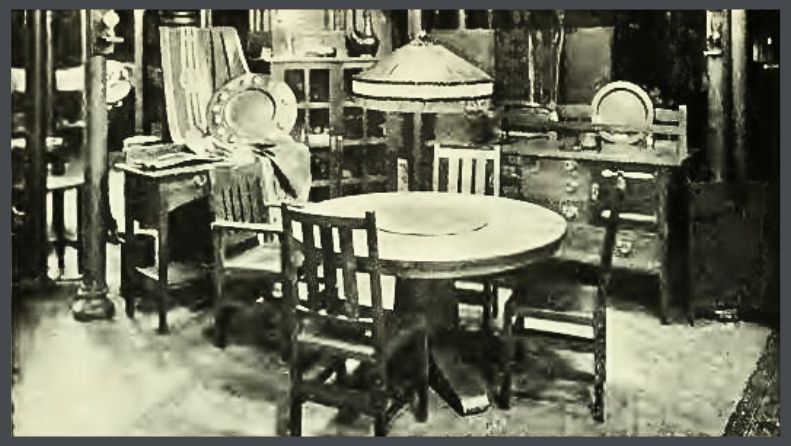
Electric dome light for dining room
Since evening is often the time when each member of the family is most at liberty to enjoy the home, it appears as a matter of reason that it should, wherever possible, be well and artistically lighted. In fact light stands for cheerfulness as well as brilliancy, for decoration as well as utility, for cosiness as well as sharp disclosures. Whatever else may be the qualities of the home furnishings, yet are they dependent upon whether a cursory or a careful study has been given to their illumination.
The true craftsman planning his residence will have taken the first great step when he has chosen a sensible location for the lighting outlets. Whether these outlets be for a ceiling light, a table lamp, or a wall bracket, they settle once and for all the place of the light source. Consequently they ought not to be passed over lightly, but should be discussed fully with the architect’s electrical expert or with a competent illuminating engineer. The location determines where the most light will ordinarily be and where the shadows will fall; it influences the choice of the fixture, the placing of furniture, and other perfectly tangible items that a glance into the near future will generally disclose.
THE ENTRY
On the lower floor the lighting of porch and doorway are of utmost importance. Outlets by each side of the doorway for wall lanterns are necessary to secure ornamentation, while beneath one such outlet may be provided a connection for an illuminated house number. If the porch be of considerable length it is well to provide two ceiling lights, symmetrically spaced, for general service. Often a low wall or floor receptacle is appreciated when a table lamp is used for outdoor reading in summertime.
THE LOWER FLOOR
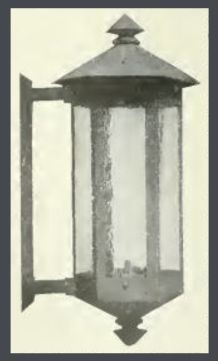
Simple type of electric bracket lantern
In the reception hall the lighting outlet—and one is sufficient—must appear symmetrical with regard to a front window, this being often the place where a light burns when all others are turned out. In case there are no other lights used, such as a newel lamp, an effort should be made to so place this ceiling outlet that ample illumination is furnished for the stairs ; furthermore, the light should be so directed that the shadow of one stair tread is not thrown on the one below.
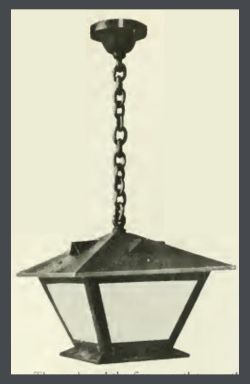
Novel design for electric lantern
On the beamed ceiling in the living room it is logical to have the outlets appear at the two places which are symmetrical with the nook, the window-seat, the dining-room doorway, and at centers of equal rectangles of ceiling surface, that general uniform lighting may be secured. Outlets for brackets on each side of the window-seat take care of decorative lights. Provision for electrical attachments in the center of the floor and low in the wainscoting at one side will always be serviceable for the family reading table and writing-desk lamps.
The nook and the fireplace should have two well placed bracket outlets that provide for reading, and two places for portable lamp attachments on a level with the mantel-shelf. A piano lamp may be connected at the nearest bracket or attached to a baseboard receptacle.
THE DINING ROOM
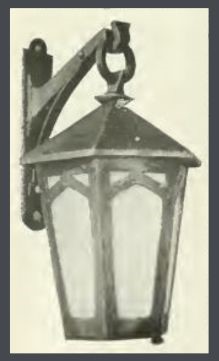
Electric bracket lantern
The dining room should have the central ceiling outlet for the table dome, the two brackets each side of the buffet, and the wainscoting receptacle. The latter, as a hint for economy in wiring cost, is sometimes located in the partition wall opposite a similar outlet in the living room. A floor outlet beneath the central dining table will be convenient for electric table candies.
PANTRIES, CLOSETS & KITCHEN

Square electric lantern
Pantries and closets are well-lighted from a central ceiling lamp, the kitchen likewise, due care being taken to have considerable light fall over the left shoulder of the person standing before the stove.
A bracket light over the left end of the sink board will facilitate operations there.
Usually a single ceiling light on the rear porch high enough to light the treads of the porch steps will suffice.
THE SECOND FLOOR
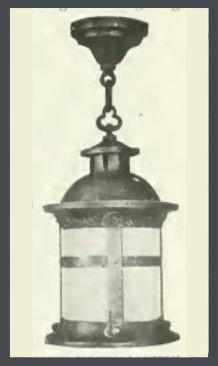
Round electric lantern
The placing of the lighting outlets on the second floor does not involve as much thought, since the desire is usually for some simple type of central ceiling fixture to light the bedrooms uniformly, assisted by local lamps, one on each side of a dresser or mirror.
By all means the best bath room equipment must include an outlet for brackets each side of a shaving mirror, since one on the left is insufficient.
Much of the ultimate success of home lighting depends on the common sense control or switching devices that are used. Wall switches are a necessity for all ceiling lights. The so-called “three-point” or “fourpoint” switches are indispensable in enabling the lower hall lights to be turned on or off from either upper or lower halls; and the upper hall light to be similarly controlled from above or below.
Small button switches can be placed in the base or canopies of wall brackets, while door switches that operate automatically with the opening and closing of closet doors are great savers of current and will pay for themselves many times over. Another economical device often found in well appointed houses consists of tell-tale or “pilot” lamps—small colored lights placed in easy view in some much occupied room, and which are arranged to burn whenever lights in basement or attic are burning. Lights in such places often burn forgotten for days at a time before discovery, and to such waste the pilot lamps call attention.
Finally, a master switch to control all the lights of the home at once and from a given place will prove the best burglar scaring device possible.
LIGHT BULBS & SHADES

Detail showing two common forms of shade holders
Bare lamp bulbs must never be exposed to view unless they are frosted. The most flagrant violations of this rule occur when the glass shade is too small, or too flat, or when the wrong shade holder is used. For all ordinary electric shades there are but two types of holders, designated as forms “O” and “H.” These are readily distinguishable since the first one mentioned is shallow, and the latter is about one inch deeper.
The sketch shows these two types in their essential features, and shows furthermore how the same shade may be held in its correct place down around the lamp or too high up on it.
Sometimes the shade holders are in the form of a casing or “husk,” completely enclosing the socket, in which event the husk must be originally made of the correct length for the exact shade and lamp combination that is to be used. Common holders, such as shown in the sketch, are readily detachable from the socket, so form “H'”may be substituted for form “O,” or vice versa.
A COMMON MISTAKE

Craftsman standard lamp with woven willow shade
These facts are primary and essential. The householder can allow his lighting installation to be marred more often by using one form of holder where the other type should be used than by any other mistake- a result the most glaring fault is the one in which the lamp bulb projects below the lower rim of the shade, causing a large loss of lighting efficiency and a harmful, glaring light from exposed lamp filaments.
Even bulbs in correct positions in shades should be frosted on their lower end, or “bowl frosted,” except perhaps in certain very deep and narrow types of shades.
A residence shade should protect the eves; redirect the light rays of highly decorative accessories, limiting them to certain areas, and also heighten aesthetic effects through the charm of warm and cool colors. These are procurable in a great many designs of shades that are of so-called milkglass, which diffuses and reflects the rays and which, when substituted for the cheaper crystal roughed shades, soon pays for itself.
Colored shades are of many kinds. Some are good reflectors, or comparatively small absorbers of light, and these of course will be chosen first. They have decidedly different appearances and tints when lighted than when “cold,” a fact which should not be overlooked in purchasing.
SIZES AND TYPES OF BULBS
The lamp bulbs themselves, if we grant electricity to be the source of light, must be of the sizes recommended by the shade manufacturers or equally competent authorities. Undoubtedly the greatest saving of expense comes from the use of the tungsten or metal filament lamps. Variations of one of the three general classes of lighting fixtures, namely, the direct, the indirect, or the semi-indirect, would
be suitable for many rooms in the home.
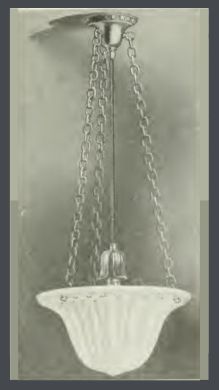
Lighting fixture of the indirect type
Briefly, these types are interdistinguishable in that the direct lighting system employs one-arm or several-arm fixtures with downward pointing open bottom shades; the indirect uses inverted opaque reflectors that throw all of their rays upward to the ceiling surface, from whence the light is broadly diffused; and the semi-indirect system uses inverted shades or bowls of translucent glass or cloth, giving some directly downward diffused light and some light that is broadly spread about, after having been thrown to the ceiling.
The accompanying illustration of the semi-indirect glass bowl and three-chain support is a typical one of this last and deservedly popular type. Such a semi-indirect fixture would be excellent in a hallway of ordinary dimensions, if we, in placing it, take due care that it will not shine directly into the eyes of a person descending the stairs. Similar types of bowls are well chosen for the library of many homes, as one of the illustrations here discloses, for such fixtures prevent glare and form soft and cheerful units. Portable lamps in conjunction with such ceiling fixtures fit in admirably and are in themselves, worthy of much attention.
The end-
Take a look at my Pinterest page to view more examples of Stickley lighting & furniture. If you should like to learn more about Stickley, you can watch some great videos here.
THIS IS JUST PART 2 OF AN IN-DEPTH SERIES ON LIGHTING
Read them all!
![]() Part 1, OUT OF THE DARKNESS
Part 1, OUT OF THE DARKNESS
The harnessing of light.
![]() Part 3, THE LIGHTING OF THE A & C ERA
Part 3, THE LIGHTING OF THE A & C ERA
How lighting expresses the philosophy & aesthetic of the Movement.
![]() Part 4, ARTS & CRAFTS LIGHTING DESIGNERS
Part 4, ARTS & CRAFTS LIGHTING DESIGNERS
Taking a look at how this new technology provided a market & how the market was served.
![]() Part 5, WOMEN IN ARTS & CRAFTS LIGHTING
Part 5, WOMEN IN ARTS & CRAFTS LIGHTING
2 women who contributed to the Movement with their beautiful lamps.
![]() Part 6, ANTIQUE ARTS & CRAFTS LIGHTING RESOURCES
Part 6, ANTIQUE ARTS & CRAFTS LIGHTING RESOURCES
If you want something authentic, but not a museum piece.
![]() Part 7, MODERN DAY ARTS & CRAFTS LIGHTING MASTERS
Part 7, MODERN DAY ARTS & CRAFTS LIGHTING MASTERS
Craftsmen honoring the tradition.
![]() Part 8, REPRODUCTION ARTS & CRAFTS RESOURCES
Part 8, REPRODUCTION ARTS & CRAFTS RESOURCES
Another beautiful option.
STAY IN THE BUNGALOW KNOW!!!
Sign up for our newsletter & receive our FREE E-book, 7 VITAL Things to Do Before You Hire a Contractor.




0 Comments